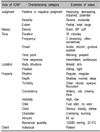Abstract
Objective
Archetypes as structured models of clinical content are considered to be the key broker between the reference models and terminology. This study developed and validated archetypes for nursing problems with breast cancer patients.
Methods
Archetypes were developed with the focuses and characterizing categories to describe the nursing problems identified from the perioperative nursing records of breast cancer patients, a literature review and experts' survey. The archetypes were validated by experts and applied to the clinical cases.
Results
Forty seven focuses and 22 characterizing categories of nursing problems were identified. Forty five archetypes, except for the symptoms of URI and vital signs, could be grouped into 16 different types. The symptoms of URI and vital signs were modeled by a combination of other archetypes. The experts' evaluation and application to clinical cases demonstrated the validity of the archetypes developed.
Figures and Tables
References
1. Mead CN. Data interchange standards in healthcare IT-computable semantic interoperability: now possible but still difficult, do we really need a better mousetrap? J Healthc Inf Manag. 2006. 20(1):71–78.
2. Kalra D. Semantic interoperability deployment and research roadmap. EU Workshops in Brussels. 2007.
3. Park HA, Hardiker N. Clinical Terminologies: a solution for semantic interoperability. J Korean Soc Med Informatics. 2009. 15(1):1–11.

4. ISO/TC215. Health informatics - Integration of a reference terminology model for nursing. 2003. Geneva: Switzerland;ISO 18104.
5. Garde S, Knaup P, Hovenga E, Heard S. Towards semantic interoperability for electronic health records: Domain knowledge governance for openEHR archetypes. Methods Inf Med. 2007. 46(3):332–343.
6. Garde S, Heard S, Hovenga E. Archetypes in electronic health records: making the case and showing the path for domain knowledge governance. 2005. In : 13th Australian Health Informatics Conference;
7. Sordo M, Palchuk MB. Greenes RA, editor. Chapter 15. Grouped knowledge elements. Clinical decision support; the road ahead. 2006. Academic Press.
8. Oniki T. Clinical Element Models at Intermountain Healthcare. Paper presents at the EHR Symposium in Seoul. 2008.
9. R&D Center for Interoperable EHR. Integrated Medical Terminology Development. 2007.
10. Beale T. Archetypes: constraint-based domain models for future-proof information systems. OOPSLA 2002 workshop on behavioural semantics. 2002.
11. The openEHR archetype definitions and principles. openEHR Foundation. Accessed December 10, 2007. Available at: http://www.openehr.org/svn/specification/TAGS/Release-1.0.1/publishing/roadmap.html.
12. The openEHR architecture overview. openEHR Foundation. Accessed December 10, 2007. Available at: http://www.openehr.org/svn/specification/TAGS/Release-1.0.1/publishing/roadmap.html.
13. Hovenga E, Garde S, Heard S. Nursing constraint models for electronic health records: a vision for domain knowledge governance. Int J Med Inform. 2005. 74(11-12):886–898.

14. Ocean archetype editor. Ocean informatics. Accessed May 11, 2009. Available at: https://wiki.oceaninformatics.com/confluence/display/TTL/Archetype+Editor+Releases.
15. Caine RM, Bufalino PM. Nursing care planning guides for adults. 1987. Baltimore: Williams & Wilkins.
16. Ignatavicius DD, Workman ML, Mishler MA. Medical surgical nursing: a nursing process approach. 1995. 2nd ed. Philadelphia: W.B. Saunders Company.
17. Carpenito-Moyet LJ. Nursing care plans & documentation: nursing diagnoses and collaborative problems. 2004. Baltimore: Lippincott.
18. Suh MJ. Adult nursing. 2000. Seoul: Sumoon.
19. Kim KS, Kang HS, Kim JI, Choi KO. Physical assessment. 1996. Seoul: Seoul National University Press.
20. Jarvis C. Physical examination and health assessment. 2004. 4th ed. St. Louis, Mo: Saunders.
21. Nettina SM. The Lippincott Manual of nursing practice. 2006. 8th ed. Philadelphia: Lippincott Williams & Wilkins.
22. Lee EO, Suh M, Kim MJ, Kim CS, Han KJ, Park YS, et al. Nursing diagnosis and intervention. 1992. Seoul: Seoul National University Press.
23. Park HA, Kim JE, Cho IS. Nursing diagnosis·intervention·outcome classification. 2000. Seoul: Seoul National University Press.
24. Seoul National University Hospital Nursing Department. Standardized nursing statements based clinical nursing process. 2007. Seoul: Hyunmoon.
25. Report on nursing vocabulary standardization. Standardization committee on academic and research vocabulary. 2006.
26. Nursing vocabulary. Standardization committee on academic and research vocabulary. 2006.
27. ICNP browser version 1.1. ICN. Accessed December 10, 2008. Available at: http://browser.icn.ch/.
28. Newman ML, Brennan M, Passik S. Lymphedema complicated by pain and psychological distress: a case with complex treatment needs. J Pain and Symptom Manage. 1996. 12(6):376–379.

31. ISO/TC215. Health informatics-conceptual framework for patient findings and problems in terminologies. 2007. DTS 22789.
32. openEHR clinical archetypes. openEHR Foundation. Accessed May 26, 2009. Available at: http://www.openehr.org/knowledge/.




 PDF
PDF ePub
ePub Citation
Citation Print
Print










 XML Download
XML Download